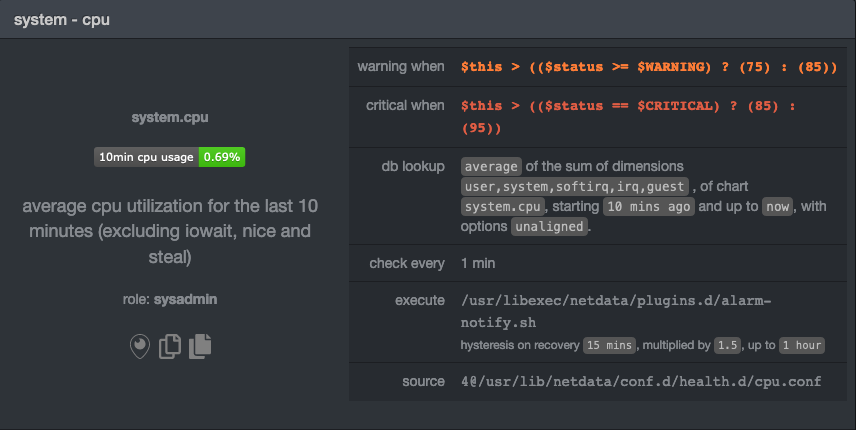1
2
3
4
5
6
7
8
9
10
11
12
13
14
15
16
17
18
19
20
21
22
23
24
25
26
27
28
29
30
31
32
33
34
35
36
37
38
39
40
41
42
43
44
45
46
47
48
49
50
51
52
53
54
55
56
57
58
59
60
61
62
63
64
65
66
67
68
69
70
71
72
73
74
75
76
77
78
79
80
81
82
83
84
85
86
87
88
89
90
91
92
|
<!--
title: "Stop notifications for individual alarms"
custom_edit_url: https://github.com/netdata/netdata/edit/master/docs/guides/monitor/stop-notifications-alarms.md
-->
# Stop notifications for individual alarms
In this short tutorial, you'll learn how to stop notifications for individual alarms in Netdata's health
monitoring system. We also refer to this process as _silencing_ the alarm.
Why silence alarms? We designed Netdata's pre-configured alarms for production systems, so they might not be
relevant if you run Netdata on your laptop or a small virtual server. If they're not helpful, they can be a distraction
to real issues with health and performance.
Silencing individual alarms is an excellent solution for situations where you're not interested in seeing a specific
alarm but don't want to disable a [notification system](https://github.com/netdata/netdata/blob/master/health/notifications/README.md) entirely.
## Find the alarm configuration file
To silence an alarm, you need to know where to find its configuration file.
Let's use the `system.cpu` chart as an example. It's the first chart you'll see on most Netdata dashboards.
To figure out which file you need to edit, open up Netdata's dashboard and, click the **Alarms** button at the top
of the dashboard, followed by clicking on the **All** tab.
In this example, we're looking for the `system - cpu` entity, which, when opened, looks like this:

In the `source` row, you see that this chart is getting its configuration from
`4@/usr/lib/netdata/conf.d/health.d/cpu.conf`. The relevant part of begins at `health.d`: `health.d/cpu.conf`. That's
the file you need to edit if you want to silence this alarm.
For more information about editing or referencing health configuration files on your system, see the [health
quickstart](https://github.com/netdata/netdata/blob/master/health/QUICKSTART.md#edit-health-configuration-files).
## Edit the file to enable silencing
To edit `health.d/cpu.conf`, use `edit-config` from inside of your Netdata configuration directory.
```bash
cd /etc/netdata/ # Replace with your Netdata configuration directory, if not /etc/netdata/
./edit-config health.d/cpu.conf
```
> You may need to use `sudo` or another method of elevating your privileges.
The beginning of the file looks like this:
```yaml
template: 10min_cpu_usage
on: system.cpu
os: linux
hosts: *
lookup: average -10m unaligned of user,system,softirq,irq,guest
units: %
every: 1m
warn: $this > (($status >= $WARNING) ? (75) : (85))
crit: $this > (($status == $CRITICAL) ? (85) : (95))
delay: down 15m multiplier 1.5 max 1h
info: average cpu utilization for the last 10 minutes (excluding iowait, nice and steal)
to: sysadmin
```
To silence this alarm, change `sysadmin` to `silent`.
```yaml
to: silent
```
Use one of the available [methods](https://github.com/netdata/netdata/blob/master/health/QUICKSTART.md#reload-health-configuration) to reload your health configuration
and ensure you get no more notifications about that alarm**.
You can add `to: silent` to any alarm you'd rather not bother you with notifications.
## What's next?
You should now know the fundamentals behind silencing any individual alarm in Netdata.
To learn about _all_ of Netdata's health configuration possibilities, visit the [health reference
guide](https://github.com/netdata/netdata/blob/master/health/REFERENCE.md), or check out other [tutorials on health monitoring](https://github.com/netdata/netdata/blob/master/health/README.md#guides).
Or, take better control over how you get notified about alarms via the [notification
system](https://github.com/netdata/netdata/blob/master/health/notifications/README.md).
You can also use Netdata's [Health Management API](https://github.com/netdata/netdata/blob/master/web/api/health/README.md#health-management-api) to control health
checks and notifications while Netdata runs. With this API, you can disable health checks during a maintenance window or
backup process, for example.
|
